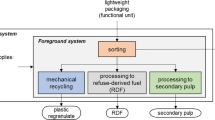Abstract
German packaging law demands an increase in the plastic packaging recycling quota from 36% to 63% by 2022. Application of inorganic crystalline fluorescent substances for tracer-based sorting (TBS) provides an innovative approach to meet this recycling goal. TBS is already applied in industry to separate ground polyvinylchloride (PVC) window profiles with and without fiber reinforcement with a sorting capacity of 0.5–2.5 t/h. In Germany, a TBS recycling system for post consumer packaging is being developed, starting with bottles as a model product. More than 80% of end-of-life plastic bottles from households show colors and transparency in favor of TBS. Selected trivalent lanthanide elements – erbium (Er3+), holmium (Ho3+), and thulium (Tm3+) – serve as effective tracer materials. These markers result in bright emission lines in green, red and near-infrared (NIR, at 800 nm) when excited with 980 nm laser light. This process of upconverting light – such that the energy of the emitted photons is greater than that of incident photons – is a unique anti-Stokes process. Tracer substances as a part of the printing ink used on labels or directly on the packaging were identified to be most efficient for industrial application. Mixtures of these tracer substances were applied on samples with a 100 µg/cm2 concentration. In total 15 samples were tested, and experiments demonstrated that 11 marker combinations out of the 15 can be identified, based on the ratio of the individual signals. Using tracers as additives in the ppm range renders products identifiable by optical identification regardless of the polymers’ physical or chemical properties, thus sorting for product properties becomes possible. Examples include distinguishing food from non-food packaging, or identification of hazardous goods, even if identical packaging materials are being used.
Access this chapter
Tax calculation will be finalised at checkout
Purchases are for personal use only
Similar content being viewed by others
References
Geueke, B., Groh, K., Muncke, J.: J. Clean. Prod. 193, 491–505 (2018)
European Commission: Closing the loop – An EU action plan for the circular economy (COM(2015)614 final) (2015). Accessed 7 Aug 2018
United Nations: Transforming our world: the 2030 agenda for sustainable development (A/RES/70/1) (United Nations)
Plastics Europe: Plastics – The facts 2018: an analysis of European plastics production, demand and waste data. Plastics Europe, Brussels (2018)
European Commission: A European strategy for plastics in a circular economy (COM(2018) 28 final) (2018). Accessed 6 July 2018
Ragaert, K., Delva, L., van Geem, K.: Waste Manage. (New York, N.Y.) 69, 24–58 (2017)
Ignatyev, I.A., Thielemans, W., Vander Beke, B.: ChemSusChem 7, 1579–1593 (2014)
Gesetz zur Fortentwicklung der haushaltsnahen Getrennterfassung von wertstoffhaltigen Abfällen: VerpackG
Brunner, S., Fomin, P., Kargel, C.: Waste Manage. (New York, N.Y.) 38, 49–60 (2015)
Bezati, F., Froelich, D., Massardier, V., Maris, E.: Resour. Conserv. Recycl. 55, 1214–1221 (2011)
Ahmad, S.R.: Environ. Technol. 25, 1143–1149 (2004)
Dvorak, R., Kosior, E., Moody, L.: Development of NIR detectable black plastic packaging. Final report (2011)
Rewindo: Kunststofffenster-Recycling in Zahlen 2018, Bonn (2018)
Charter, M., Clark, T.: Sustainable Innovation: Key Conclusions from Sustainable Innovation Conferences 2003–2006. Organised by The Centre for Sustainable Design, Farnham (2007)
Cancino, C.A., La Paz, A.I., Ramaprasad, A., Syn, T.: Technological innovation for sustainable growth. An ontological perspective. J. Clean. Prod. 79, 31–41 (2018)
Gasde, J., Preiss, P., Lang-Koetz, C.: Integrated innovation and sustainability analysis in collaborative R&D projects. In: Proceedings of the ISPIM Innovation Conference – Celebrating Innovation: 500 Years, Since da Vinci
Gasde, J., Klinke, C., Woidasky, J., Lang-Koetz, C.: Integrierte Innovations- und Nachhaltigkeitsanalyse im Bereich Sortierung und Verwertung von LVP-Abfällen Tagungsband des Wissenschaftskongress „Abfall- und Ressourcenwirtschaft“, pp. 99–103. Deutsche Gesellschaft für Abfallwirtschaft e.v.; Innsbrück University Press, Innsbrück (2019)
Acknowledgements
Substantial part of the research reported in the above contribution was made possible by a grant of the German Federal Ministry for Education and Research (BMBF) as a part of the framework program “Research for Sustainable Development” (FONA3) on the topic “Plastics in the environment” with grants no. 033R195A-E under supervision of the project executing organization Jülich (PTJ). The authors are thankful to Mrs. Gabriella Loveday (Pforzheim University) for proofreading this contribution.
The sole responsibility for this text is with the authors.
Author information
Authors and Affiliations
Corresponding author
Editor information
Editors and Affiliations
Rights and permissions
Copyright information
© 2020 Springer-Verlag GmbH Germany, part of Springer Nature
About this paper
Cite this paper
Woidasky, J. et al. (2020). Photoluminescent Tracer Effects on Thermoplastic Polymer Recycling. In: Hopmann, C., Dahlmann, R. (eds) Advances in Polymer Processing 2020. Springer Vieweg, Berlin, Heidelberg. https://doi.org/10.1007/978-3-662-60809-8_1
Download citation
DOI: https://doi.org/10.1007/978-3-662-60809-8_1
Published:
Publisher Name: Springer Vieweg, Berlin, Heidelberg
Print ISBN: 978-3-662-60808-1
Online ISBN: 978-3-662-60809-8
eBook Packages: EngineeringEngineering (R0)




